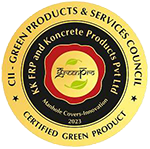The manufacturing process of Fiber-Reinforced Polymer (FRP) involves several steps, including the selection of fibers, preparation of the polymer matrix, combining the fibers and matrix, and forming the composite into the desired shape. The specific process can vary based on the type of fibers, resin, and the intended application. Here is a general overview of the FRP manufacturing process:
- Fiber Selection:
- The process begins with the selection of suitable reinforcing fibers. Common fibers include glass (fiberglass), carbon, aramid, and basalt. The choice of fiber depends on the desired properties of the final composite, such as strength, stiffness, and cost.
- Polymer Matrix Preparation:
- The polymer matrix is typically made from a liquid resin. Common resin types include epoxy, polyester, and vinyl ester. The resin may be further modified with additives to achieve specific properties. The combination of fibers and resin is critical in determining the final characteristics of the FRP composite.
- Preparation of Prepreg (Optional):
- In some cases, the reinforcing fibers are pre-impregnated with the resin to create prepreg material. This ensures a consistent resin-to-fiber ratio and facilitates handling during the layup process.
- Layup:
- The layup process involves arranging the reinforcing fibers in the desired orientation within a mold or on a tooling surface. The fibers can be laid up manually or using automated processes. The arrangement of fibers is critical in determining the strength and directional properties of the final product.
- Resin Infusion or Injection (Optional):
- In some manufacturing processes, resin is infused or injected into the fiber arrangement. This helps ensure that the fibers are fully wetted with resin, creating a strong bond between the fibers and the matrix.
- Vacuum Bagging:
- The layup may be covered with a vacuum bag to remove air and excess resin. The vacuum bagging process helps improve the consolidation of the composite, reducing voids and enhancing the overall quality.
- Curing:
- The composite is then cured or hardened. Curing can occur through the application of heat, either in an oven or an autoclave, depending on the type of resin used. The curing process transforms the liquid resin into a solid matrix, creating a strong bond with the reinforcing fibers.
- Demolding:
- Once the curing is complete, the composite is demolded. The demolding process involves removing the formed FRP composite from the mold or tooling.
- Trimming and Finishing:
- The cured composite may undergo trimming to achieve the desired shape and dimensions. Additional finishing processes, such as sanding or painting, may be performed to meet specific aesthetic or functional requirements.
- Quality Control:
- The final FRP product undergoes quality control measures, including inspection for defects and testing to ensure it meets the required specifications.
The specific details of each step in the FRP manufacturing process can vary based on factors such as the type of application, the choice of materials, and the scale of production. Manufacturers may use different techniques and variations of the process to achieve the desired properties in the final FRP composite.





